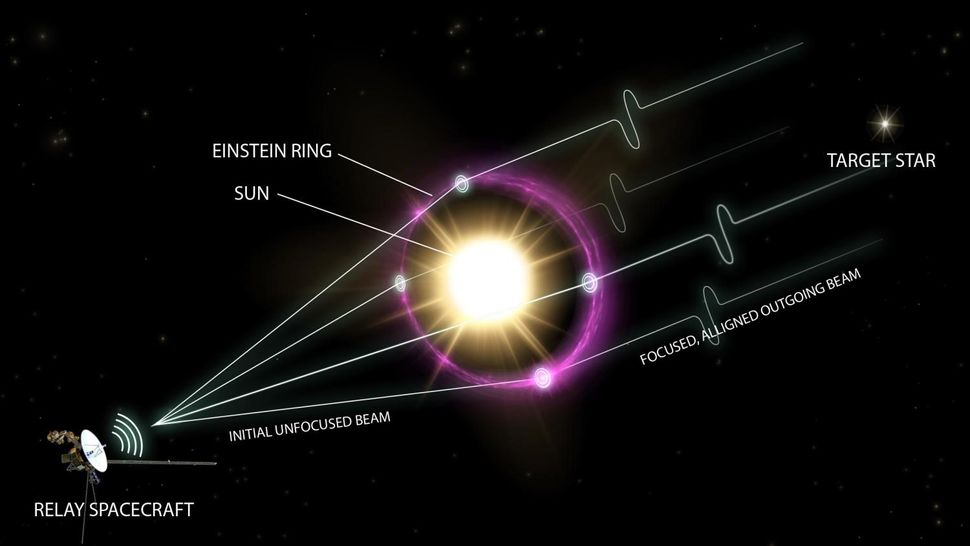Plans to use a solar lens date back to the 1970s. More recently, astronomers have proposed developing a fleet of small, lightweight CubeSats that would deploy solar sails to accelerate them to 542 AU. Once there, they would slow down and coordinate their maneuvers, creating an image and sending data back to Earth for processing.
Using a phenomenon known as gravitational lensing, it would be possible to use the Sun as a giant telescope to peer into deep space. There are incredibly powerful telescopes that have given us spectacular views of space and glimpses into the early days of the universe. These observatories, like the James Webb Space Telescope (JWST), are amazing feats of engineering that have required billions of dollars and decades of work.
But what if we could get access to an even better telescope that already exists? It wouldn’t be a typical telescope. It wouldn’t even have a lens. But it would be the most powerful telescope we’ve ever built. It would use the Sun itself.
To get some idea of how powerful a solar-powered telescope can be, consider the JWST. With a mirror 21.3 feet (6.5 meters) in diameter, the JWST can achieve a resolution of about one-tenth of an arc second, or about 600 times better than the human eye. At that resolution, the telescope could see the details on a coin 25 miles (40 kilometers) away, or pick up the pattern on a soccer ball 342 miles (550 kilometers) away.
Another example is the Event Horizon Telescope, which is actually a network of individual instruments scattered around the world. By carefully coordinating its elements, the telescope has given us spectacular images of gas disks surrounding giant black holes. To do this, it achieved an impressive resolution of 20 microarcseconds. At that resolution, the telescope could see an orange on the surface of the Moon.
But what if we want to go even bigger? A bigger telescope would require either giant dishes or networks of antennas flying across the solar system, both of which would require huge leaps in our technological capabilities.

An illustration showing how gravitational lensing around the Sun might work. Dani Zemba/Penn State, CC BY-NC-ND 4.0
Luckily, there is already a giant telescope located right at the center of the solar system: the Sun.
While the sun may not look like a traditional lens or mirror, it does have a lot of mass. And in Einstein’s general theory of relativity, massive objects warp the space-time around them. Any light that hits the sun’s surface is bent and, instead of continuing in a straight line, is sent toward a focal point along with all the other light that hits the sun at the same time.
Astronomers are already using this effect, called gravitational lensing, to study the most distant galaxies in the universe. When light from these galaxies passes close to a giant galaxy cluster, the mass of that cluster intensifies and magnifies the background image, allowing us to see much further than we normally could.
The “solar gravitational lens” results in almost unbelievably high resolution. It’s as if we had a telescope mirror the width of the entire sun. An instrument positioned at the right focal point could use the gravitational curvature of the sun’s gravity to allow us to observe the distant universe with a stunning resolution of 10^-10 arc seconds. That’s about a million times more powerful than the Event Horizon Telescope.
There are, of course, problems with using the sun’s gravitational lens as a natural telescope. The focal point of all that light refraction is 542 times farther away than the distance between the Earth and the sun. That’s 11 times the distance to Pluto and three times the distance reached by humanity’s farthest spacecraft, Voyager 1, which launched in 1977.
So not only would we have to send a spacecraft farther than ever before, but it would also have to have enough fuel to stay there and keep moving. The images created by the sun’s gravitational lens would be scattered across tens of kilometers of space, so the spacecraft would have to scan the entire field to create a complete mosaic.
While it may sound outlandish, the concept isn’t that far off. And what would we get with such a supertelescope? If it were aimed at Proxima b, the closest known exoplanet, for example, it would provide a resolution of 1 kilometer. Given that plans for JWST’s successors call for exoplanet imaging capabilities where the entire planet fits into a handful of pixels, the solar gravitational lens puts those ideas to shame; it could provide an exquisite portrait of the detailed surface features of any exoplanet within 100 light years, not to mention all the other astronomical observations it could make.
To say it will be better than any telescope we know is an understatement. It will be better than any telescope we could build in any possible future over the next few hundred years. The telescope already exists — we just need to put the camera in the right position.




